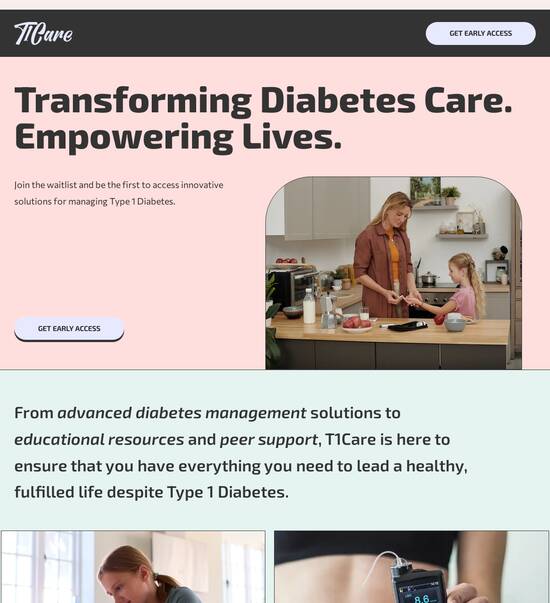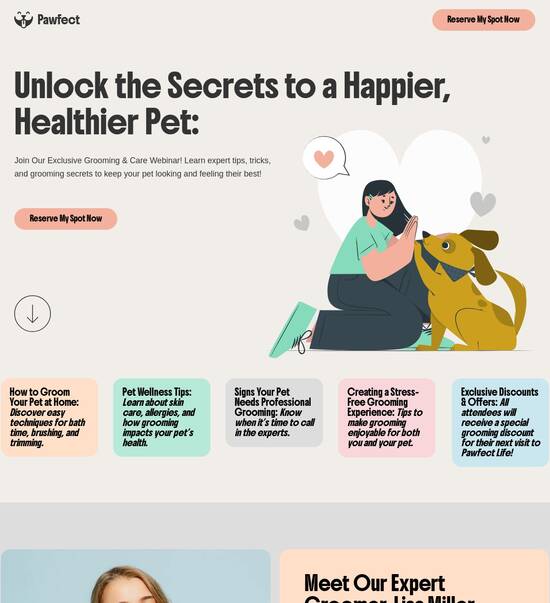
React.js optimized referral page template
Explore Similar TemplatesAbout template
Supercharge your referral page with React.js for outstanding performance! Learn more today.
Recommended templates

Easy to build without coding
With the intuitive drag-and-drop builder, anyone on your team can create high-converting pages without any knowledge of code or design. Make enhancements to your landing page with custom widgets using Javascript, HTML/CSS, or third-party scripts.

Multiple layouts for any industry and goal
Select from 500+ landing page layouts built to boost conversions across industry-specific scenarios. Customize them by adjusting fonts, adding images, and generating on-brand content with the AI assistant. Quickly scale with Instablocks® and Global Blocks that you can save, reuse, and update globally.

Loads fast and looks polished on any device
Every template is responsive, which means they present professionally on any device and load blazingly fast with our Thor Render Engine. You can also power them up with Google AMP technology to deliver an unparalleled mobile experience and drive higher conversions.

Robust analytics & experimentation
Get real-time updates and reporting across all your devices, showing the number of visitors, conversions, cost-per-visitor, and cost-per-lead. Launch AI-powered experiments, run A/B tests, and use heatmaps to analyze user behavior, then optimize your landing page to maximize conversions.







Easy to build without coding
With the intuitive drag-and-drop builder, anyone on your team can create high-converting pages without any knowledge of code or design. Make enhancements to your landing page with custom widgets using Javascript, HTML/CSS, or third-party scripts.
Multiple layouts for any industry and goal
Select from 500+ landing page layouts built to boost conversions across industry-specific scenarios. Customize them by adjusting fonts, adding images, and generating on-brand content with the AI assistant. Quickly scale with Instablocks® and Global Blocks that you can save, reuse, and update globally.
Loads fast and looks polished on any device
Every template is responsive, which means they present professionally on any device and load blazingly fast with our Thor Render Engine.
Robust analytics & experimentation
Get real-time updates and reporting across all your devices, showing the number of visitors, conversions, cost-per-visitor, and cost-per-lead. Launch AI-powered experiments, run A/B tests, and use heatmaps to analyze user behavior, then optimize your landing page to maximize conversions.
All the features you need to build lead-generating landing pages
Explore more featuresLearn how to build top-performing landing pages for any goal
FAQs
Leading the way in building high-performing landing pages





A comprehensive guide to Instapage's landing page and CRO platform
Instapage is the most powerful tool for marketers looking to enhance their digital marketing campaigns through high-converting landing pages. With its all-in-one platform, Instapage offers features that not only accelerate campaign performance but optimize and scale results, ultimately maximizing ROI. As you navigate the world of digital marketing, understanding how to effectively utilize Instapage can set you apart in competitive sectors like business services, tech, and education.
Understanding Instapage's Key Features
Instapage equips marketers with an intuitive platform to create and test landing pages. Its standout features include access to over 100 customizable templates, built-in optimization tools, and dynamic personalization options. Each of these elements plays a crucial role in converting visitors into leads, providing marketers with the resources needed to succeed without the prior experience of a developer.
- High-converting templates: Instapage provides over 100 readymade templates designed for optimal performance, allowing marketers to hit the ground running.
- Built-in experimentation: Marketers can leverage tools for A/B testing and heatmaps to enhance page performance based on user behavior.
- Dynamic personalization: Content can be tailored to specific audiences using AdMaps and dynamic text replacement, ensuring a targeted approach.
Getting Started with Instapage: Step 1 - Choose Your Template
Selecting the right template is crucial. Begin by identifying the goal of your landing page—whether lead generation, product promotion, or event registration. Once you've pinpointed the purpose, browse through the extensive template offering and select one that aligns with your marketing objectives.
Getting Started with Instapage: Step 2 - Customize Your Page
After selecting a template, customization is key to ensuring your landing page resonates with your target audience. Utilize the drag-and-drop builder to make real-time edits. Incorporate your branding elements, such as logos, colors, and fonts to maintain consistency with your overall marketing strategy.
- Edit text blocks: Ensure that all text aligns with your brand’s messaging and is geared towards conversion.
- Add images and videos: Visual elements can significantly enhance engagement, so utilize high-quality media related to your offerings.
- Integrate lead generation forms: Ensure that forms are prominently placed and easy to fill out to drive higher conversions.
Getting Started with Instapage: Step 3 - Test and Optimize
With your page live, the next step is to monitor performance. Use Instapage’s built-in analytics dashboard to assess conversion rates and user interactions. Conduct A/B tests to experiment with different elements on your page, adjusting based on empirical data to maximize effectiveness.
- Track user behavior: Leverage heatmaps to understand where visitors are clicking and adjust accordingly.
- Run A/B tests: Split traffic between variations of your page to see which elements perform best.
- Analyze metrics: Regularly review detailed analytics to inform future updates and enhancements.
By effectively leveraging Instapage, marketers can create high-impact landing pages that convert visitors, demonstrating the power of optimization and personalization in digital marketing.
Ready to launch your next campaign? Start with Instapage today to supercharge your landing pages and achieve remarkable results!
ReactJS optimized referral page template
Understanding the fundamentals of referral pages in ReactJS
Referral pages serve a crucial role in driving engagement and conversions through the implementation of referral marketing strategies. Essentially, a referral page functions as a dedicated landing destination where users can learn about and participate in referral programs, instilling a sense of community and incentivizing word-of-mouth marketing. By detailing the benefits of referring friends or colleagues, these pages create a compelling case for users to act. Effective referral pages often feature interactive elements that encourage sharing, detailed statistics to showcase potential rewards, and user-friendly designs to enhance navigation.
Utilizing ReactJS for building referral pages offers unique advantages. The component-based architecture of ReactJS makes it easy to create reusable elements that can be employed across the page. This improves the development process by speeding up the delivery of responsive features while maintaining a consistent look and feel. Moreover, React's ability to offer smooth interactions aids in creating a pleasant user experience; users can easily navigate through the steps of the referral process without unnecessary distractions.
Component-based architecture for easy reusability
Enhanced user experience due to smooth interactions
Performance optimization through the virtual DOM
Key components of an optimized referral page template
Engaging design elements are foundational to capturing and retaining user interest on a referral page. Users are likely to abandon sites that lack visual appeal or easily navigable layouts. The use of eye-catching headlines paired with strong visuals can create a striking first impression. Additionally, ensuring that the page layout is responsive allows for a seamless experience across various device types, from desktop monitors to mobile screens. Furthermore, strategically placing call-to-action buttons is vital for directing users to the next steps, leading to increased engagement levels.
User-centric content strategies are essential for influencing conversion rates. Employing persuasive language that clearly outlines the benefits of participating in the referral program can significantly impact user behavior. Incorporating testimonials and social proof effectively helps assuage potential users' concerns, as social validation increases trustworthiness. Understanding the nuances of different user segments permits the tailoring of content, ensuring it resonates with distinct audience needs.
Create eye-catching headlines along with appealing visuals
Utilize responsive layouts to cater to various devices
Strategically place call-to-action buttons for higher engagement
Technologies powering the referral page template
A solid foundation in core technologies is vital for developing an optimized referral page template. JavaScript and JSX are crucial for ensuring dynamic rendering and user interaction. Additionally, leveraging state management libraries like Redux or the Context API can simplify data flow and manage the application’s state effectively, particularly as the complexity of the application grows. It's also essential to provide seamless integration with back-end services through RESTful APIs, allowing for real-time updates and user data handling.
Beyond these core technologies, considering additional tools and libraries enhances the development process. Styling frameworks such as Styled Components or Tailwind CSS allow for quick and easy layout designs that match brand aesthetics while making styling maintainability easier. Effective routing solutions are fundamental for intuitive user experiences, creating natural and fluid transitions between different components or pages. Lastly, incorporating reliable testing frameworks like Jest or React Testing Library guarantees that the referral page operates as intended without unexpected glitches.
JavaScript and JSX ensure dynamic rendering
State management libraries streamline data handling
Integration with back-end services via RESTful APIs
Building the template: step-by-step process
To begin building an optimized referral page template, setting up the development environment is crucial. This includes installing the necessary software and dependencies tailored for the project, as well as cloning any existing template files that can be optimized. Utilizing a consistent coding structure aids in streamlining collaboration and reducing the likelihood of errors throughout the development cycles.
Structuring the page with components requires careful planning. Reusable components serve as the backbone of your referral page, allowing for layout consistency while enabling you to make updates across the board. By leveraging props for component properties and state for managing user interactions, you can create dynamic content that reflects user activity in real-time. Ultimately, connecting the referral page to back-end services is essential for fetching user data and implementing referral links and tracking codes, which are indispensable for monitoring engagement and conversions.
Set up the development environment with required software
Create reusable components for consistent layouts
Fetch user data for personalized experiences
Previewing and testing the referral page
Before launching the referral page, it's important to engage with React Dev Tools for component inspection to visualize component hierarchies. This analysis allows developers to identify potential performance issues and optimize component rendering. Addressing these concerns during the development stage prevents complications once the page goes live. Successful testing incorporates real user interaction, allowing insights into usability that can lead to refinements that enhance overall user experience.
Organizing usability tests with actual users creates a feedback loop that empowers developers to adapt the referral page based on real-world data. Observing how users interact with the page informs actions taken post-launch. Furthermore, deploying a seamless solution involves selecting hosting platforms optimized to support ReactJS applications, which benefits from established CI/CD practices to ensure smooth rollouts and updates.
Use React Dev Tools to inspect components
Conduct usability tests to gather user feedback
Select optimized hosting platforms for deployment
The role of communities and collectives in development
Engaging with developer communities is extremely beneficial when it comes to refining a ReactJS optimized referral page template. Platforms such as GitHub and Stack Overflow provide invaluable resources for developers to share their experiences, troubleshoot issues, and discover best practices. Participating in discussions and examining diverse perspectives enriches the development experience and can reveal innovative solutions that may not have been previously considered.
Moreover, building a collaborative network with design and marketing teams creates synergies that lead to more effective solutions. By pooling expertise and resources among developers and marketers, common issues can be addressed more efficiently, leading to a referral page that not only meets technical standards but also aligns with marketing goals. Understanding market trends and behavior enhances the overall impact of the referral page.
Engage with platforms for sharing experiences
Build a collaborative network with design and marketing teams
Pool resources for troubleshooting common issues
Innovative ways to enhance referral page performance
Utilizing analytics is crucial for measuring the effectiveness of a referral page in terms of conversion rates. By regularly reviewing metrics such as click-through rates and overall engagement, decisions can be informed that will boost performance. Analyzing user behavior through these insights allows for necessary adjustments, whether it's refining content language or experimenting with different design layouts to see what resonates best with the audience.
Incorporating innovations in referral marketing practices can set a brand apart. Conducting A/B tests on various content versions and CTAs helps optimize messaging and understand the preferences of the target audience. Additionally, user-generated content can provide authentic perspectives that attract new users, hence playing a pivotal role in improving trust and credibility for the referral program.
Review analytics to drive improvements in conversions
Conduct A/B testing for better optimization
Leverage user-generated content to enhance authenticity
Navigating questions and challenges in referral page design
Developers often face common concerns when creating referral pages, such as balancing aesthetic design with functionality. While visually appealing designs are essential, they should not come at the expense of performance and user experience. Meeting usability standards across devices and ensuring seamless interactions leads to higher retention rates. Performance management becomes especially critical under high traffic loads; finding the optimal balance will prevent slow response times that can deter potential users.
To mitigate these challenges, adopting best practices is key. Optimizing load times through image compression, leveraging caching strategies, and minimizing resource requests can significantly enhance performance without sacrificing quality. Moreover, ensuring mobile responsiveness across different platforms guarantees that all user segments have a pleasant experience, thereby driving better engagement and higher referrals.
Balance aesthetics with functionality in design
Manage performance effectively under high traffic
Ensure mobile responsiveness for a diverse audience
Future trends in referral page development
The landscape of referral page development is continually evolving as new technologies emerge. Anticipating changes in frameworks and tools that will influence how referral pages are constructed can help developers stay ahead of the curve. Incorporating technologies such as server-side rendering or progressive web apps may become standard practices, yielding improved load times and better user experiences.
As user behavior shifts, adapting to emerging strategies in customer engagement, including personalization at scale and gamification, will enhance the overall effectiveness of referral marketing. Integrating AI-driven tools for optimizing user experiences through personalized recommendations will pave the way for better results, allowing brands to cultivate loyalty and drive more referrals.
Monitor predictions on next-gen frameworks and their impact
Adapt strategies in customer engagement and loyalty programs
Leverage AI for personalized user experiences
Ready to skyrocket conversions?
Supercharge your ad campaigns with high-performing landing pages
Get started














